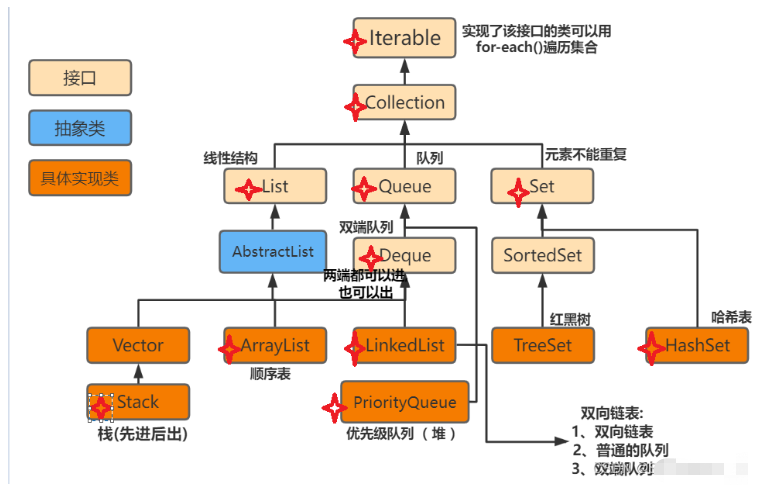
In Java, there is a set of ready-made data structures, such as sequence lists, linked lists, queues, stacks, priority queues, hash tables, etc., which are encapsulated into corresponding interfaces/classes for programmers to directly To use it, you only need to create the relevant objects to use, without the need to implement its internal structure.
A collection is a data structure that stores and manages multiple elements, where these elements are placed in a single unit and can be processed through operations such as addition, deletion, modification, and query. For example, a set of playing cards (a collection of cards), an address book (a set of mapping relationships between names and phone numbers), etc. can be used as examples.
The picture below is very important! ! ! You need to remember its commonly used interfaces and classes! !


Because the map interface does not implement the Iterable interface, how to traverse the elements in it?
Map<Integer,String> map = new HashMap();
map.put(1,"jack");
map.put(2,"tom");
Set<Map.Entry<Integer, String>> entries = map.entrySet();
// 使用迭代器进行遍历 ,增强 for同理
Iterator<Map.Entry<Integer, String>> iterator = entries.iterator();
while (iterator.hasNext()) {
Map.Entry<Integer, String> entry = iterator.next();
System.out.println(entry.getKey() + " " + entry.getValue());
} Taking HashMap as an example, you can call its entrySet() method to encapsulate each
Basic relationship (simplified version)

is generally accepted by an interface or class that implements the Collection interface Specifically implement the object of the class, because as can be seen from the above figure, the Collection interface is the parent interface of a series of interfaces and classes. It has relatively few internally implemented methods, so it cannot call some common methods of subclasses.
Note: The type passed in here can only be a reference type. If it is a basic data type, its wrapper class should be used. Specify
Collection<String> collection1 = new ArrayList();
collection1.add("haha");
collection1.add("world");
Collection<Integer> collection2 = new ArrayList();
collection2.add(1);
collection2.add(2);
//collection2.add("hh");// 这里会报错,不符合传入的指定类型Integer| method | function |
|---|---|
| void clear() | Delete all elements in the collection |
| boolean isEmpty() | Determine whether the collection does not have any elements, Commonly known as the empty set |
| boolean remove(Object e) | If element e appears in the set, delete one of them |
| boolean add(E e) | Put element e into the collection |
| int size() | Return the number of elements in the collection |
| Object[] toArray() | Returns an array containing all elements in the collection |
Note: In the last Object[] toArray() method, an array of type Object[] is returned. The underlying method is: take out the elements in the collection one by one, convert them into Object objects, and store them in the array to be returned. , and finally returns an array of type Object[]. A type conversion exception is thrown when converting to a String[] array.

Because there is no guarantee that every element in the array is converted to String, but it is only forced to be converted into an array of type String[], so if you have to To convert, you need to first traverse the returned results, convert them to String type one by one, and finally assign them to an array of String[] type. It is not recommended to convert the array type as a whole in Java.
Object[] objects = collection1.toArray();
String[] strings = new String[objects.length];
for (int i = 0; i < objects.length; i++) {
strings[i] = (String)objects[i];// 一个一个转,但是没啥必要
}stores data in the form of < k, v > key-value pairs. The key value here is unique, and each key value can correspond to its The corresponding value value. Different key values can correspond to the same value. HashMap: When storing elements, the internal hashCode function is called based on its key value to find the location where the element should be placed. Therefore, the elements in the hash table are not stored in the order in which they are stored.
| Method | Function |
|---|---|
| V get(Object k) | Find the corresponding v according to the specified k |
| V getOrDefault(Object k, V defaultValue) | According to the specified k Search for the corresponding v, if not found, return the default value |
| V put(K key, V value) | Put the specified k-v into the Map |
| boolean containsKey(Object key) | Judge whether it contains key |
| boolean containsValue(Object value) | Judge whether it contains value |
| Return all key-value pairs | |
| Determine whether it is empty | |
| Return the number of key-value pairs |